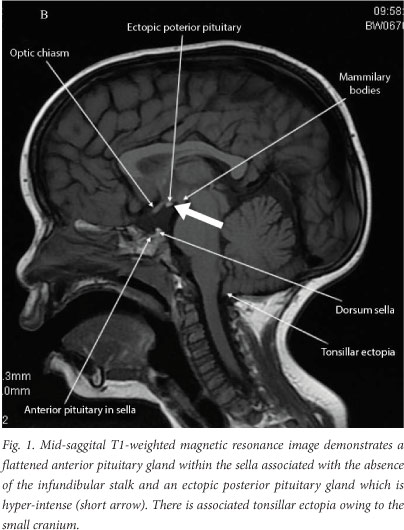Services on Demand
Article
Indicators
Related links
-
 Cited by Google
Cited by Google -
 Similars in Google
Similars in Google
Share
South African Journal of Surgery
On-line version ISSN 2078-5151
Print version ISSN 0038-2361
S. Afr. j. surg. vol.51 n.4 Cape Town Jan. 2013
CASE REPORT
The ectopic posterior pituitary gland
N Mahomed; T Motshudi
Department of Diagnostic Radiology, Faculty of Health Sciences, University of the Witwatersrand, Johannesburg, South Africa
ABSTRACT
An ectopic posterior pituitary gland is a rare condition and may present with an empty pituitary fossa, hypoplasia or absence of the infundibular stalk and resultant short stature due to growth hormone deficiency. The location of the ectopic lobe can vary, but it is most commonly situated along the median eminence in the floor of the third ventricle. We report a case of an ectopic posterior pituitary gland, describe the causes and discuss the diagnostic imaging features.
Case report
An 8-year-old boy presented to paediatric endocrinology with short stature, delayed bone age and biochemical features suggestive of hypopituitarism. Magnetic resonance imaging of the brain demonstrated a flattened anterior pituitary gland within the sella, associated with absence of the infundibular stalk and an ectopic posterior pituitary gland (Fig. 1). There was associated tonsillar ectopia due to the small cranium.

Discussion
An ectopic posterior pituitary gland is a rare condition and may present with an empty pituitary fossa, hypoplasia or absence of the infundibular stalk and resultant short stature due to growth hormone deficiency.[1] It may be associated with septo-optic dysplasia, Chiari I malformation, agenesis of the corpus callosum, Kallmann sydrome and peri-ventricular heterotopias.[1,2] The location of the ectopic lobe can vary, but it is most commonly located along the median eminence in the floor of the third ventricle.[1,2]
Causes of an ectopic posterior pituitary gland include defective neuronal migration during embryogenesis, tumours, trauma, or surgical transection of the pituitary stalk.[3,4] Usually the anterior pituitary gland is absent, or attenuated and reduced in height, and the infundibular stalk may not be visible.[3] The infundibular stalk is best assessed after injection of gadolinium. Signal hyperintensity in the posterior aspect of the pituitary gland on T1-weighted images is related to the paramagnetic effect of the vasopressin-neurophysin II co-peptin complex.[1]
REFERENCES
1. Ginat DT, Meyers SP. Intracranial lesions with high signal intensity on T1-weighted MR images: Differential diagnosis. Radiographics 2012;32(2):499-516. [http://dx.doi.org/10.1148/rg.3221057611 [ Links ]
2. Mitchell LA, Thomas PQ, Zacharin MR, Scheffer IE. Ectopic posterior pituitary lobe and periventricular heterotopia: Cerebral malformations with the same underlying mechanism? AJNR Am J Neuroradiol 2002;23(9):1475-1481. [ Links ]
3. Saleem SN, Said AH, Lee DH. Lesions of the hypothalamus: MR imaging diagnostic features. Radiographics 2007;27(4):1087-1108. [http://dx.doi.org/10.1148/rg.274065123] [ Links ]
4. Van der Linden AS, Van Es HW. Case 112: Pituitary stalk transection syndrome with ectopic posterior pituitary gland. Radiology 2007;243(2):594-597. [http://dx.doi.org/10.1148/radiol.2432040385] [ Links ]
 Correspondence:
Correspondence:
N Mahomed
(nasreen.mahomed@wits.ac.za)














